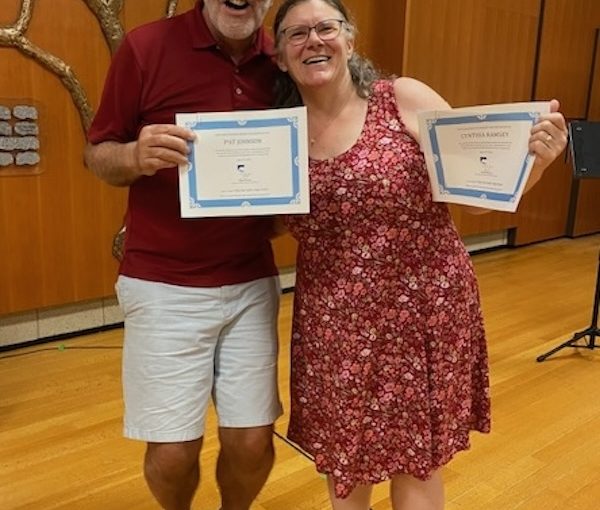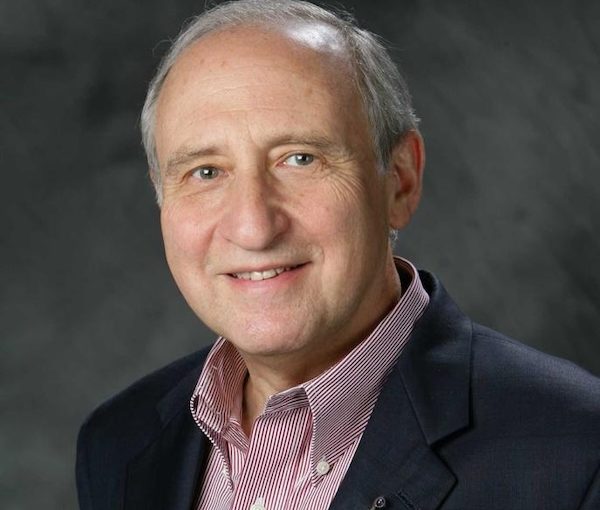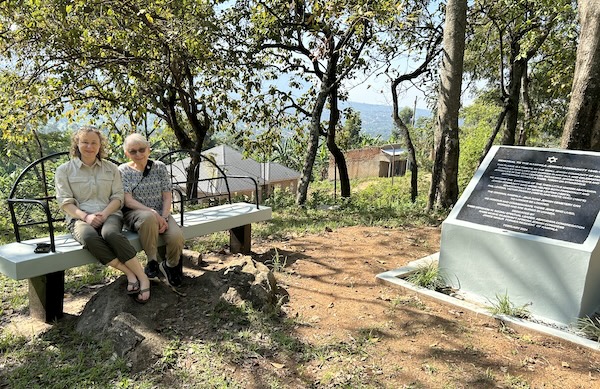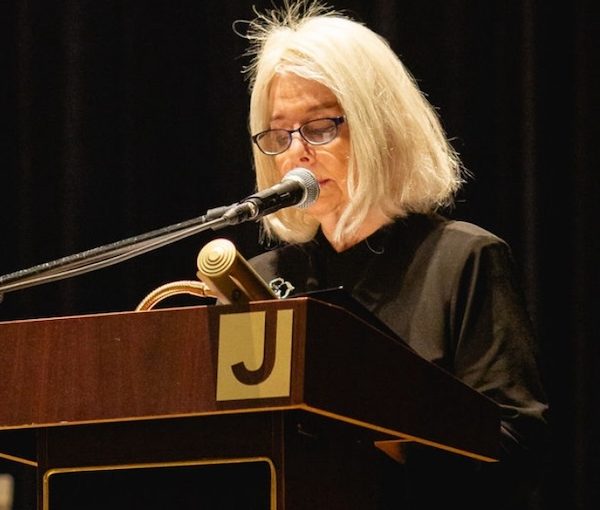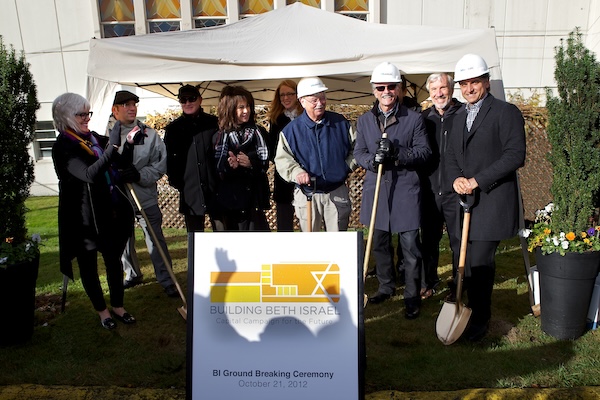Pat Johnson and Cynthia Ramsay after their presentation about the Jewish Independent at Congregation Har El’s Seniors Lunch July 17. The pair were asked to participate by lunch organizers Tim Newman and Kala Solway. They each received a certificate of thanks and a thank-you gift from Noga Vieman, the synagogue’s programming and education director. (photo by Lorraine Katzin)
Tag: history
A picture is worth a thousand words
In the first few years of 1900, my paternal grandparents – who had been married since 1886 – came to a decision. Economic life in Pinsk was too challenging and a drastic lifestyle change was required. So, in 1905, my grandfather, Yehiel Rubachka, age 34, journeyed alone from Pinsk (then under control of czarist Russia) to find work in Toronto. He knew Yiddish and a bit of Russian, having served in the Russian army for three years. He left behind my 27-year-old grandmother, Liba, and their four young children, Bessie (born in 1899), David (1902), Minnie (1903) and Herschel (1905), in Pinsk Karlin. Today, Karlin might be called a suburb of Pinsk.
On the one hand, Pinsk, with its sizeable and well-organized Jewish population (according to Yad Vashem, 21,819 or 77.3% of the city’s population, in 1896) offered the comfort of the familiar. On the other hand, living conditions were not good. By the time my grandfather left Pinsk, he and my grandmother had buried five children. There were also political and social issues, such as the fact that, in czarist Russia, Jews by and large lived under restrictions: forbidden to settle or acquire land outside the cities and towns, legally limited in attendance at secondary school and higher schools, virtually barred from legal professions, denied the right to vote for municipal councilors, and excluded from serving in the navy or the guards. Not to mention the repercussions of the failed 1905 Russian revolution, and the deaths and damage done by periodic Cossack attacks.
It is not clear what my grandfather’s relocation ultimately meant. For all intents and purposes, entering Canada was fairly easy; he did not need a passport or a visa to enter the country. But did he go to Toronto to test the waters so to speak – perhaps Canada would turn out to be no better than eastern Europe? Or was his plan, from the start, to make enough money to bring over the rest of the family? Or was it all left open-ended? On the birth certificate of one of my aunts, his occupation in Canada was listed as a (humble) rag collector.
In any case, around 1906, my grandparents decided a family portrait was needed. (Since my Uncle Herschel still looks like an infant, this photo was probably produced earlier than the 1910 date my father held to.) The problem, of course, was that the family was based in two distant locations, Toronto and Pinsk. So how was such a picture taken?
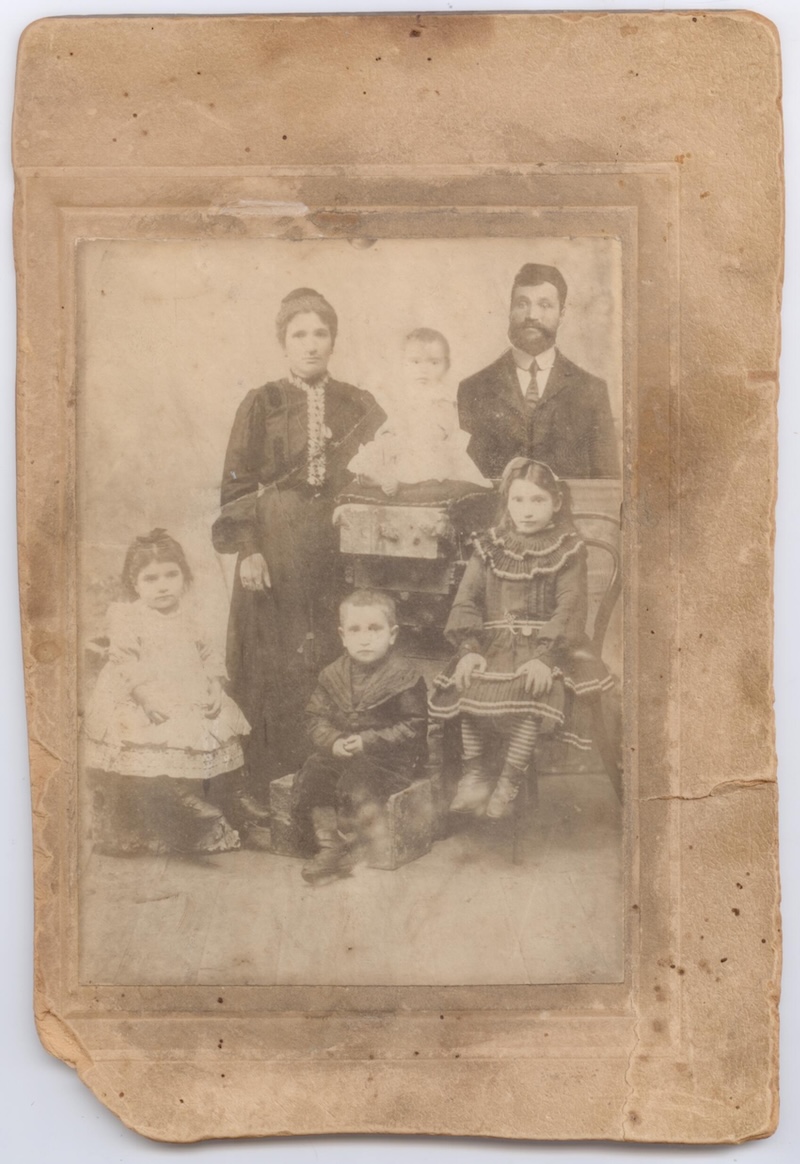
According to Rita Margolin, a Yad Vashem historian, glass plate negatives were in use from the 1850s through the 1920s. They were popular with both amateur and professional photographers. In these years before courier and other delivery services, it would have been tricky to safely send glass negatives, they might have shattered in mailing. This suggests that some other method was used for putting together the two photos that became the family portrait.
Margolin further elaborated that a Pinsk photographer named Rendall might have made the composite image, as he was active in Pinsk in 1910. She pointed out, however, that photographers generally displayed their name on the photos they took, and my family’s photo is lacking a signature both on the front and the back side. (It is probably not a good idea with my unskilled hands to search for a signature by separating this very old photo from the cardboard to which it is pasted.) The lack of signature might mean that the photo I have is a copy and not the original.
Early 20th-century photo studios preferred photomontage – the production of images by physically cutting and joining combined photos – to create, for instance, tall-tale postcards. Tall-tale postcards are also known as “exaggerations.” Examples of these kinds of postcards include hilarious old farming photos in which farmers are seen pushing a wheelbarrow or a wagon containing giant harvested onions or enormous potatoes.
According to my father, the late Sidney (also known by his Yiddish name, Sheya) Rubin, z’l, my grandfather was added to the picture. One photographer with whom I consulted agreed that this is a likely scenario, as normally the head of the family would be prominently featured in the front, rather than the back, row of a photo.
In my family’s photograph, my grandmother is standing, facing the camera, straight on and straight-faced. My Aunt Bessie is sitting on a wooden chair while my Aunt Minnie is sitting on what might be a tree stump. My Uncle Dave is sitting on a suitcase. The baby, my Uncle Herschel, dressed in some sort of baby’s gown, sits atop a stack of cases. My grandfather, with a somewhat wistful look on his face, is cleverly placed behind a trunk, with only his upper torso visible.
My grandfather’s family left Pinsk and joined him in Canada in 1911. Sadly, all the relatives who remained in Pinsk were killed in the Shoah. My father’s family settled at Toronto’s 13 Leonard Ave. Between 1880 and 1928, 70,000 Jews left Russian-held territory for Canada.
Four more children were born in Toronto. These included two more aunts, one uncle and my father. Rachel or Rae was born in 1911, Birdie (often called by her Yiddish name Faigel) was born in 1913, Harvey (often called Mo) was born in 1915 and my father was born in 1917. My father’s family, however, did not remain in Toronto. In 1920, they moved to the United States, settling in Chicago. Along the way, the family name was changed to Rubin. My grandfather’s first name was anglicized to Joseph and my grandmother’s first name was anglicized to Elizabeth (or Lizzie). My grandfather became a naturalized American citizen in 1953. By that time, he had been living in the United States for more than 30 years but, still, he signed his naturalization papers in Yiddish.
As a child, I remember visiting the street where my father had lived as a young child. Perhaps surprisingly, the missionaries still had a close-by storefront. According to reports, missionaries had been “working” in the area since the time my grandfather was living in Toronto. Although they apparently succeeded in converting very few Jews, it did not stop them from trying for years on end.
Photoshop and other digital photo editing tools are a great help to today’s photographers. In the early 1900s, of course, computers and such programs did not exist. Yet, in the early 1900s, photographers on two continents managed to make a composite image nonetheless.
Deborah Rubin Fields is an Israel-based features writer. She is also the author of Take a Peek Inside: A Child’s Guide to Radiology Exams, published in English, Hebrew and Arabic.
Enjoy a glass of Israeli wine – the award-winning industry has struggled since Oct. 7 attacks
According to historian and former ambassador Michael Oren, on Oct. 8, 2023, one day after the terror group Hamas’s brutal assault on southern Israel, the following things happened: 80% of Israelis volunteered to help in any way they could, 360,000 Israelis reported for military duty and thousands of Israelis who were not in Israel on Oct. 7 returned to defend their country.
This remarkable resilience and dedication have also been apparent in Israel’s wine industry. Workers from wineries that could finish their 2023 harvests went to other wineries to help with harvesting and winemaking. A poignant example is the support for Kibbutz Nir Oz’s winery. When Kibbutz Nir Oz was attacked, Hamas murdered the winemaker, Gideon Fauker, z’l, and took his two partners captive to Gaza, where they remain today. In a recent Israel21c article, Andrea Samuels recounts how people in Israel’s wine industry came together to turn Nir Oz Winery grapes into wine and save the vintage, to honour their Nir Oz colleagues.
Jews have been making wine in the land of Israel for more than 3,000 years, a fact confirmed by archeological evidence. King David had vast vineyards and kept large stores of wine, and wine was a major export and economic mainstay for Jews during the time of the Second Temple in Jerusalem. Even when outsiders invaded the land and mandated pulling out the vines many centuries later, a limited number of vines remained to produce wine for sacramental purposes. Viticulture was reintroduced in the late 19th century and, by the end of the 20th century, Israel was garnering international recognition for the quality of its wines. Today, there are more than 300 wineries of all sizes in Israel, and a well-established wine culture.
Since the massacres and kidnappings by Hamas on Oct. 7, the wineries have faced tremendous obstacles due to the ensuing war with Hamas in Gaza and daily rocket and missile attacks on northern Israeli land and communities by the terror group Hezbollah. There are labour shortages, as Israelis are repeatedly called up for reserve duty and many foreign workers have left the country. In the north, some employees who have been evacuated because of the Hezbollah attacks can’t get to the wineries. Any work at the wineries and vineyards in this prized Galilee viticulture region remains a dangerous proposition and there is concern for the 2024 vintage. Vineyards in the north and south have been damaged by rockets and some in the north are inaccessible in closed military zones. Domestic wine sales, on which the wineries heavily rely, plummeted after Oct. 7 and, although they have recovered somewhat, a tourism decline and restaurant and bar closures have exacerbated the sales slump. And, of course, there is the human cost as the wars and threats continue and as many in Israel’s wine industry have lost family, friends and co-workers.
Despite these challenges, the people of Israel’s wine industry have shown classic Israeli resilience, determination, collaboration and commitment to the country and to one another. Samuels’s article noted that, since Oct. 7, Alex Haruni and his Dalton Winery team have been making Shabbat dinners for soldiers posted at the nearby Lebanon border. And, in his article “A taste of total victory,” Adam Montefiore, a 38-year veteran of Israel’s wine industry, wrote about Tom Carbone and his Be’eri Winery.
Carbone and his friend Dror Or, z’l, the Be’eri Dairy cheesemaker who was murdered by Hamas when they attacked the kibbutz, had a dream of collaborating to make Kibbutz Be’eri a food and wine tourism destination. Carbone is working to fulfil that dream for both of them, commuting to Be’eri from the hotel he and his family now live in at the Dead Sea. So far, he has produced an outstanding Be’eri Chardonnay and is continuing his friend’s work at the dairy.
We in Canada can support Israel in many ways, including by buying and enjoying the beautiful wines of her irrepressible wineries. Israeli wines available in British Columbia are highlighted below with tasting notes.
GALIL MOUNTAIN WINERY
Established in 2000 as a joint venture between Golan Heights Winery and Kibbutz Yiron, Galil Mountain Winery (galilmountain.co.il) has five vineyards in the Upper Galilee mountains, with topographical and climatic conditions well-suited to growing grapes of the highest quality for wine production.
Galil Mountain Cabernet Sauvignon 2022: A young, refreshing character with accentuated fruity aromas. No barrel aging. The wine was stored in stainless steel tanks after fermentation to preserve its fruity character.
Varietal: Cabernet Sauvignon
Colour: deep opaque purple
Aroma: pure ripe raspberry and blueberry primary fruit character, with hints of herbs and tobacco leaf
Taste: a medium-to-full bodied wine with delicate tannins; the finish is long and firm
Food: best served at 64°F (18°C) to accompany a wide range of meat dishes
 Galil Mountain Rosé 2021: A dry, light rosé with refreshing acidity. A combination of two winemaking techniques – skin contact followed by cold fermentation.
Galil Mountain Rosé 2021: A dry, light rosé with refreshing acidity. A combination of two winemaking techniques – skin contact followed by cold fermentation.
Varietal: a blend of Sangiovese, Barbera, Pinot Noir
Colour: bright pink
Aroma: scents of strawberry, pomegranate and ripe nectarine with notes of blooming wildflowers
Taste: presents characters of flowers, strawberry and pomegranate; a joyful wine with invigorating and well-balanced acidity
Food: try with a fresh summer salad, with sushi or as an aperitif on its own
Galil Mountain Alon White 2020: The grapes are carefully selected at harvest, pressed gently, and half of the blend is fermented and aged in French oak barrels for three months.
Varietal: blend of Chardonnay, Viognier
Colour: pale lemon
Aroma: citrus blossom, alongside hints of fresh mint
Taste: ripe citrus, stone fruit and a hint of herbs on the palate, with refreshing acidity, light body and a lingering finish
Food: pairs beautifully with grilled fish and fresh salads
GOLAN HEIGHTS WINERY
Golan Heights Winery (golanwines.co.il) gained international recognition after releasing its first wines in 1984 and led a winemaking revolution that put Israel on the world wine map. The Golan Heights, a volcanic plateau with rich basaltic soil, is the coldest region of the Galilee appellation and considered the best for viniculture.
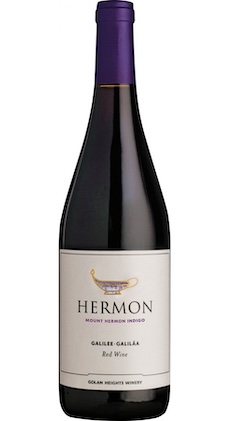 Mount Hermon Indigo 2022: Made from classic varietals, a young medium-bodied wine full of flavour.
Mount Hermon Indigo 2022: Made from classic varietals, a young medium-bodied wine full of flavour.
Varietal: blend of Cabernet Sauvignon, Syrah
Colour: deep indigo-purple
Aroma: black currant, tobacco and smoke
Taste: medium bodied with notes of raspberry and black cherry, characters of aniseed and cocoa, and hints of flowers and earth
Food: beef brisket, grilled lamb shanks or a barbecued beef burger
TEPERBERG 1870 WINERY
Teperberg 1870 Winery (teperberg1870.co.il) is located in the foothills of the Jerusalem Mountains with vineyards in several growing regions. It is one of the oldest wineries in Israel, founded in Jerusalem in 1870 and, for a time, known as Efrat Winery. Efrat remains a label of Teperberg 1870. The Teperberg and Efrat wines listed are mevushal, wine that has been flash pasteurized.
 Teperberg Malbec Vision 2021: The Malbec Vision undergoes stainless steel fermentation and is aged in French and American oak for five months prior to release.
Teperberg Malbec Vision 2021: The Malbec Vision undergoes stainless steel fermentation and is aged in French and American oak for five months prior to release.
Varietal: Malbec
Colour: deep red with purple hints
Aroma: black fruits and spices
Taste: a deep and layered wine that combines a wealth of fruit with vibrant acidity
Food: beef dishes, charcuterie, beet salads
Teperberg Efrat White Blend 2022: Fermentation in insulated chilled stainless steel tanks for two weeks before the final blend is composed. To retain its crispness, the wine does not undergo malolactic fermentation.
Varietal: blend of Riesling, Semillon, French Colombard
Colour: light, pleasant yellowish
Aroma: mainly citrus aromas
Taste: fresh, balanced with pleasant acidity and medium body
Food: fried or grilled fish
Efrat Judean Hills Cabernet Sauvignon Argaman 2022: Fermentation in insulated chilled stainless steel tanks.
Varietal: blend of Cabernet Sauvignon, Argaman, Carignan
Colour: purple
Aroma: fruity aromas with black and red fruit
Taste: balanced, rich, medium-bodied with a long finish
Food: lamb dishes or pasta in meat sauce
Visit bcliquorstores.com to find a store near you with Israeli wine. L’chaim!
Rochelle Golumbia is an advocate of supporting Israel through Israeli wine and initiated Vancouver’s first Israeli wine festivals.
Srulik, meet Handala
The ways in which the characters of Srulik, left, and Handala epitomize the historical and cultural narrative of the Israelis and Palestinians, respectively, imbue these cartoons with an impact stronger than words. (photo by Gil Zohar)
Driving east from Jerusalem on the winding Jordanian-built road that once led down from the Mount of Olives to the Dead Sea, one passes through a series of picturesque Arab suburbs and soon comes to a dead end in front of the grotesque West Bank barrier.
Called Geder ha-Hafrada (separation fence) in Hebrew and jidar al-fasl al-’unsuri (apartheid wall) in Arabic, the insurmountable (if still incomplete) eight-metre-high concrete barrier has no doubt contributed to a reduction in terrorism and car theft. However, my objection to it is more existential: like some of those in West Berlin who spray-painted their protest for freedom on the Bundesrepublik side of die Mauer even as armed GDR guards used deadly force to prevent anyone from approaching the wall’s eastern side, I believe all walls must fall.
It is a metaphor that has repeated itself from Joshua’s encircling of Jericho, to the Berlin Wall and its remaining East Side Gallery, to Garth Hewitt’s ballad “They’ve Canceled Christmas in Bethlehem,” about the stranglehold the wall has placed on both day-to-day life and religious pilgrimage in the place where Jesus, “the Prince of Peace,” was born 2,000-plus years ago.
The world today is caught between two conflicting ideologies: some democratic countries joining in unions with open borders, joint legal systems and a common currency, of which the European Union – notwithstanding its problems – is a great success. Then, there are other countries – many repressive and undemocratic – defending their borders with minefields and walls. Like John Lennon, I prefer the first vision – of a growing global union without barriers. Imagine that.
Thus, armed with the tools of the graffiti artist – an X-ACTO knife, cardboard stencil and spray paint – I recently made my way to Abu Dis with my friend Hajj Ibrahim Abu el-Hawa, my daughter Bareket and fellow artist Eva Feld to make our mark. Reasoning that a picture is worth a thousand words, we chose a symbolic image whose meaning is unequivocal.
The image we created depicts Handala raising hands with Srulik (see picture). The two iconic cartoon characters are respectively well known by Palestinians and Israelis – yet, each is equally unknown by the other. It is a symmetry of ignorance of the other’s narrative that will have to be overcome before true peace can be achieved.
Allow me to explain the mirror meanings of the twin caricatures.
Handala – an omnipresent image on T-shirts and key chains in the aswaq (plural of suq, market) of Jerusalem, the West Bank and Gaza Strip – was created by Naji al-’Ali in 1969. A 10-year-old child driven in 1948 from his Galilee village of ash-Shajara (14 kilometres from Tiberias) to the ‘Ain al-Hilweh refugee camp in Lebanon, al-’Ali went on to become the leading political cartoonist in the Arab world.
Before being assassinated in London in 1987, he produced more than 40,000 bitingly sarcastic cartoons lampooning Arab leaders and lamenting the stateless status of his people. His autobiographical image of Handala – a barefoot, faceless, refugee youth – remains a potent symbol of the struggle of the Palestinian people for justice and self-determination.
Al-’Ali wrote: “Handala is my signature. I gave birth to this child in the [Persian] Gulf. He was born 10 years old, and he will always be 10. At that age, I left my homeland and, when he returns, Handala will still be 10, and then he will start growing up. The laws of nature do not apply to him. He is unique. Things will become normal again when the homeland returns.”
Impish Srulik – a diminutive of Yisrael (Israel) – carries an equally rich symbolism in depicting nascent Israel and, in particular, its native-born Sabras. The illustrated character was first drawn in 1956 by the cartoonist Kariel Gardosh, better known by his nom de plume, Dosh. The Hungarian-born Holocaust survivor drew Srulik for decades in the pages of the daily Maariv, until his death in 2000.
Dosh generally depicted Srulik as a young man wearing a kova tembel hat, “biblical sandals” and khaki shorts. He drew him as a pioneering Zionist and lover of the land of Israel, a dedicated farmer who in time of need dons an Israel Defence Forces uniform and goes out to defend the state of Israel, equipped with an Uzi machine gun. In contrast to the antisemitic stereotype of the weak or cunning Jew, which appeared in the Nazi weekly Der Stürmer and other European and Arab newspapers and journals, Dosh’s Srulik was a proud, strong and sympathetic Jewish character.
Shalom Rosenfeld, editor of Maariv from 1974 to 1980, wrote: “Srulik became not only a mark of recognition of [Dosh’s] amazing daily cartoons, but an entity standing on its own, as a symbol of the land of Israel – beautiful, lively, innocent … and having a little chutzpah and, naturally, also of the new Jew.”
Introducing Srulik to Palestinians and Handala to Israelis is not a bad way to begin to redress each side’s ignorance of the other’s narrative. The ways in which they epitomize the historical and cultural narrative of their own people imbue these cartoons with an impact stronger than words.
When a peace treaty is ultimately implemented between Israel and Palestine (as I’m sure it must), perhaps the image of Handala and Srulik holding hands could be adopted as a neutral symbol of coexistence and nonviolence. Their creators, Naji al-’Ali and Kariel Gardosh, both knew firsthand of persecution and exile, and the iconic figures they bequeathed us share the hope of living in freedom and peace. When peace finally arrives, new and emotionally satisfying images and symbols will need to be created to bridge the chasm between Jews and Arabs in our broken Promised Land.
Gil Zohar is a writer and tour guide in Jerusalem.
One family’s influence
Ben Shneiderman was the featured speaker at Jewish Senior Alliance’s Spring Forum May 26. (photo from hai.stanford.edu)
On Sunday, May 26, the Jewish Seniors Alliance presented their annual Spring Forum. Featured speaker Ben Shneiderman spoke about his family’s influence on journalism, photojournalism and the development of human-computer interactions.
Shneiderman was introduced by Gyda Chud, a past president of JSA and chair of the program committee. He told those gathered at the Peretz Centre for Secular Jewish Culture about his family history, keeping the audience enthralled throughout.
Shneiderman is an emeritus distinguished professor of computer science at the University of Maryland. He has received six honorary doctorates in recognition of his pioneering contributions to human-computer interaction and information visualization. He has published more than 20 books, most recently, Human-Centered AI (Oxford University Press, 2022), which won the Association of American Publishers award in the computer and information sciences category.
However, Shneiderman did not begin with his own cultural contributions, but with those of his parents, Samuel and Eileen (née Szymin) Shneiderman. They began their journalistic partnership in Warsaw, writing for the many Yiddish publications that existed then. Their lives mirrored the turbulent events of those years. They moved from Warsaw to Paris, where they continued to contribute to Yiddish publications. They did major reporting from Spain during the Spanish Civil War. In 1938, Samuel published a collection of his work on the Spanish Civil War in Yiddish, titled Krig in Shpanyen: Hinterland. This coverage earned him the title of being “the first Yiddish war reporter.” This book was later published in Polish and then in Spanish. It will appear soon for the first time in English as Journey through the Spanish Civil War, translated by Deborah Green and published by the Yiddish Book Centre’s White Goat Press.
In 1940, with the help of the Yiddish press in New York, the family was able to immigrate to the United States and escape the war. Samuel worked with the Yiddish press and published many other books, including editing The Diary of Mary Berg, by an American woman who was incarcerated in the Warsaw Ghetto and described harrowing details of life there. Samuel wrote of the Kielce Pogrom in Between Fear and Hope. The Weitzman National Museum of American Jewish History has two virtual exhibits: one on Samuel and Eileen’s partnership, and the second on Ben Shneiderman’s computing contributions and the photojournalism of David Seymour, Eileen’s brother, who was known as Chim.
Chim’s humanistic style of reporting influenced modern visual storytelling. One of his photos, related to the war, may have inspired a painting by Picasso. Chim’s war photos were widely published in many magazines and journals, and he became known for his unique photographs of children who had become orphans during the conflict. He also took photos of many celebrities, such as Audrey Hepburn, Maria Callas, Ingrid Bergman, and many others. Some of these images were published in popular media such as Life magazine.
Chim took some interesting shots of life in the state of Israel in the early 1950s. Of note is a photo of a wedding taken outdoors, possibly in the Judaean Hills. The chuppah is torn in a few places and one side is being held up by a rifle and a pitchfork. Chim was killed while photographing the Suez Crisis for Newsweek in 1956. He was 45 years old.
Throughout the presentation, Shneiderman replied to questions and comments, Marilyn Berger, a past president of JSA, thanked him for his inspiring words.
The next JSA event is A Summer Afternoon of Music on June 24, featuring a live concert of classical music, showtunes and Jewish songs by Trio du Souvenir – Rudy Rozanski (piano), Yu Tsai (cello) and Arnold Kobiliansky (violin). Co-sponsored with the Kehila Society and Congregation Beth Tikvah, the concert and lunch take place at Beth Tikvah. To attend, RSVP by June 21 to Toby Rubin, [email protected] (lunch is $15).
Shanie Levin is a Jewish Seniors Alliance Life Governor. She is also on the editorial committee of Senior Line magazine.
A new generation of leaders
Howard Kallner is being honoured at Schara Tzedeck’s MOSAIC gala on June 4 (photo by kenneth88/wikimedia)
“I have been very lucky in my life to be surrounded by lifelong volunteers and builders of community, both my parents, my in-laws and multiple other role models, and it just seemed natural to volunteer and be involved,” Howard Kallner told the Independent.
Kallner is being honoured by Congregation Schara Tzedeck at MOSAIC, the synagogue’s annual gala, on June 4.
“The first thing that came to my mind was discomfort,” said Kallner about finding out he was being recognized. “I was hesitant to accept because there are so many long-time shul volunteers, donors and community-builders who would be deserving of being honoured.”
Kallner has been a part of the congregation since he was 13 years old.
“My family had emigrated from South Africa when I was very young and their synagogues in South Africa were very similar to Schara Tzedeck,” he explained. “My parents, and now my family, have been members for over four decades. On my wife’s side, her great-grandfather, David Davis, was a founding member of Schara Tzedeck, and her grandfather, Charlie Davis, was a past president.”
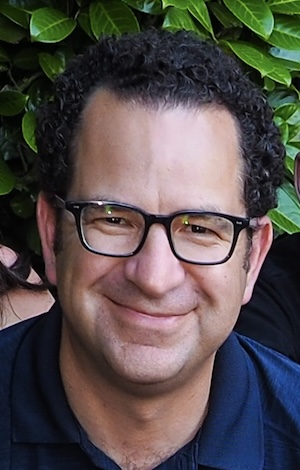
For his part, Kallner was on the board for seven years before becoming president. He served three years as president and three more as past president, for a total of 13 years. He was serving as president when the pandemic hit.
“When the COVID pandemic hit, we needed to pivot immediately to online programming, online services where applicable, continue live services with restrictions and make sure our community members, particularly our vulnerable ones, were connected and taken care of,” he said of how his role was affected. “One of the programs that came out of this was Shabbat in a Box. We recognized a need amongst our members and others in our community and delivered over 450 meals a week at the height of the pandemic. For the Jewish holidays, we were delivering over 650 meals accompanied by holiday-specific items so they could celebrate the holidays.
“Additionally, Schara Tzedeck, being an Orthodox synagogue, could not have Shabbat services online,” said Kallner. “With the exception of a few weeks when the government would not allow any public gatherings, we continued services in person with some significant modifications. When limited to 50 people per gathering, we moved services outside, in a tent in our parking lot. At times, services were held in sub-zero temperatures, with most attendees wearing ski jackets, toques and gloves. For the High Holidays that year, we had nine services a day for a maximum of 50 people. We had to find three sets of Torah readers, shofar blowers and leaders of the services.
“While, during COVID, it was undoubtedly the hardest I worked as president of the shul, it was also the most rewarding,” he said.
Now officially “just” a member and supporter of the synagogue, Kallner continues to be part of the Schara Tzedeck Cemetery Board and is a governor of the Jewish Community Foundation, as well.
“Giving back to a community that has given me and my family so much was very important,” he said. “With different experiences in my life and my relatives’ lives, including immigrating to a new country with little means and losses during the Holocaust, strong Jewish institutions ready for whatever the world would throw at them seemed crucial, and I wanted to do my part.”
Schara Tzedeck’s senior spiritual leader, Rabbi Andrew Rosenblatt, described Kallner as representing the beginnings of a new generation of leadership. At the time Kallner was getting involved, said the rabbi, “There weren’t a lot of people in their 40s who were stepping up to the highest levels of leadership at Schara Tzedeck.”
Kallner helped take the synagogue from being a 20th-century organization into being a 21st-century organization, said Rosenblatt.
”The backbone of an Orthodox synagogue, certainly in the Pacific Northwest, certainly in Vancouver, is people who have come from much more traditional Jewish communities,” he explained. “For example, Schara Tzedeck has a lot of Holocaust survivors. These are people who came from very traditional Eastern European communities, but you could also have people from Winnipeg or Toronto or Montreal, New York, those places you associate with very traditional, very committed Jewish communities. For a long time, we were able to be a community of people who grew up in that kind of tradition, but there was a recognition at Schara Tzedeck that we needed to be able to be a place which translated to people who did not have that kind of traditional upbringing.”
Kallner had the analytical, organizational and people skills to help the synagogue do that, said Rosenblatt, highlighting Kallner’s leadership during the pandemic.
“He was practically a paid member of the staff at that point, in terms of generating and developing policy,” said the rabbi. “He was involved in helping us make sure that we were operating on the next level. And he also understood that our organization had to be structured in a way where we could have the manpower to be able to do that, and that outreach. Part of that was that the information technology had to be updated.”
Describing Kallner as “a very humble person but also very hard working,” Rosenblatt said, “one of the things that he was strongest at was helping us transition into a place where we were reaching out more…. One of the programs we developed under his watch was Shabbat in a Box. There were some pre-iterations before that, but it came to its full maturity under him.”
Among the other programs that will benefit from the funds raised at MOSAIC are the synagogue’s education initiatives, some of which reach beyond the shul to the broader Jewish community, such as the series Rosenblatt gave on the history of the Marranos.
“I recognize,” he said, that “one of the great sources of inspiration in Jewish identity is Jewish history.”
Since the Oct. 7, 2023, terror attacks and the subsequent war, his education efforts have been more focused on Israel.
“When Oct. 7th hit, and people started to hear immediately just garbage about colonialization, I realized that there was just so much that people didn’t know or understand,” he said.
The Zionist story most of us have been taught is the inspirational one, he said. “Not that it’s wrong, it’s just not complete, and all histories have complexities. I didn’t want people to be caught flat-footed on these things and be surprised by them.”
He gave the example of a sign he saw on an overpass on the way into Whistler Village recently.
“It says there can be no peace on stolen land. And I’m thinking to myself who stole the land from whom? At what point do you decide that the land belongs to someone? Are you willing to say that 638 is where we’re going to start everything, when Omar ibn al-Khattab conquered Jerusalem, is that the right time? Should we ask ourselves when the Abbasids or the Fatimids or the Umayyads, which one of them? Were the Ottoman Turks? Which one becomes the real owner? At what point do you decide that these things happen? People don’t know – maybe now they do more, but certainly on October the 8th they didn’t know – when was Israel first called Palestine, when did Muslims come to Jerusalem, when were Jews forced out, which empires conquered it … what really happened at Deir Yassin, what were the stages of the War of Independence, what happened? These things, there are a lot of resources on them … and, I thought, Jews didn’t know these things – not to mention that there are libraries full of evidence on Jewish indigenous life in Israel that is far, far older than anything having to do with the name Palestine, and I wanted Jews to be able to know that. I wanted Jews to be able to articulate it. I want Jews to understand a stronger connection to Israel. And I think that has been something that has been a real value added to people’s knowledge base.”
The congregation has several individuals who have gone to do military service in Israel. “They are primarily Israelis who are here for various purposes, as shlichim [emissaries] or for educational reasons, and we’ve had real success in having them share their experiences and stories over the past number of months,” said the rabbi.
These types of programs have been a priority, said Rosenblatt, “to make sure that our community really stays close and understands the nuances and the issues. Every time we have the opportunity to give further insight, we do that.”
One of the people from Schara Tzedeck who has gone to serve was Assistant Rabbi Ishay Gottlieb. “He’s a major in the reserves in the IDF, and he left on Oct. 9th and wasn’t really back until the beginning of January,” explained Rosenblatt. “You’re essentially funding a staff member, like many Israeli organizations [are having to do], but there’s lots that had to be compensated for in that context.
“In some ways,” added Rosenblatt, “we’ve doubled our programming – run a regular program plus an Israel program. Not that we’re that different from the other synagogues [in that respect] but everything costs money and this is part of a case for giving. Since Oct. 7th, we really have been prioritizing the connection with Israel.”
He said, “When you walk into Schara Tzedeck, we want you to feel like you’re in a little embassy of Israel in this building. And participating in MOSAIC means that’s what you’re doing, you’re helping to support that – you’re helping to support a branch of Am Yisrael that is in Vancouver.”
To attend MOSAIC, RSVP by May 28 to 604-736-7607 or [email protected].
Keeping Jewish history alive
Janice Masur and her daughter, Liora Freedman, on March 3, after unveiling the memorial plaque in Nagoya village near Mbale, Uganda. (photo from Janice Masur)
I have just come back from Uganda, where my family used to live, in the Jewish community that existed from 1949 to 1961. My daughter, Liora, had returned 10 days earlier, as planned. I had to stay longer because my passport had been stolen two weeks previously, off my lap while sitting in a slow-moving car. Thankfully, after Liora involved my local member of Parliament, my temporary Canadian passport, processed in Nairobi, Kenya, finally arrived in Kampala, and I was able to leave.
Although still essentially an agricultural economy, Uganda is touted to visitors as the most entrepreneurial country in Africa. Most people in the countryside have a small plot to grow their own food and sell the surplus. Large-scale plantations of sugar cane, tea, coffee and bananas are grown for export. The Pearl of Africa is rich in mineral deposits and China is beginning to drill for oil on the edge of Murchison Falls National Park.
I could not find my way around Kampala anymore. It used to be a self-contained town situated over seven hills. Now it sprawls and spreads in all directions with Ugandan street names I can barely pronounce. My old house has a high fence and a guard at the gate, with a gun slung across his shoulder, who wouldn’t let us enter. I was charmed to find the same small five-petaled purple flowers floating down like tiny propellers, strewn on the driveway just as they had done in my childhood. Across the rutted road, there was a new modern hotel instead of modest houses.
We drove up Kibuli Hill to see Kibuli Mosque. In my day, the mosque was a friendly looking place of worship. I was shocked to see how fortress-like it had become, painted grey instead of white, with the words “None shall be worshipped but Allah. Muhammad is his prophet.”
I tried to find my bearings on Tank Hill – named for the three extremely large round water tanks in the neighbourhood – where we had once lived but couldn’t. Instead of being given help, I was told not to take photos, or I might be thought to be spying on an army unit. Important ministers travel in cars with armed guards seated outside of the cars facing sideways, guns at the ready.
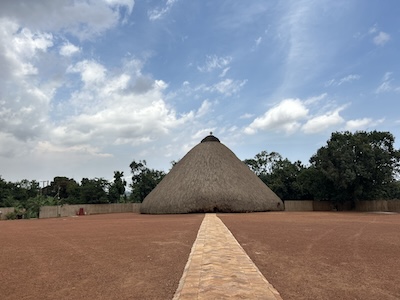
I visited the Kasubi Tombs, where the kabakas, or kings, have been buried since pre-Christian times. I had never known about this sacred UNESCO site when I lived in Uganda. A steep thatched roof, reaching almost to the ground covered intricate woven designs in the inner ceiling of one of the tombs. It was my absolute luck to have Prince Joseph as my tour guide. When I showed him a photograph, he told me proudly that he was the grandson of Edward, the brother of the kabaka, Mutesa II or Freddy, who was one of the two Ugandan men in the picture.
My purpose for traveling to Uganda was to unveil two memorial plaques for my Jewish community, which had been there from 1949 to 1961. None of the community infrastructure exists today, not even the cemetery, now submerged under real estate.
We placed a plaque in the Nagoya village near Mbale, where the Abayudaya, who converted to Judaism in 1921, live. Conservative Rabbi Gershom Sizomu and his wife, Tziporah, and others in the community were so welcoming and warm, helpful and supportive. We had a wonderful Shabbat evening, with lots of music and drumming, and Shabbat lunch under two large mango trees, with stunning views of Mount Elgon.
On Sunday, the whole community was invited to the unveiling of the plaque. We ambled down to a lower flat piece of land after morning minyan in the synagogue. There were speeches by Rabbi Sizomu and by Rabbi Netanel Kaszovitz, a young Orthodox rabbi visiting from Nairobi, who is responsible for administering to all the Orthodox Jewish communities in East and West Africa. The plaque glowed in the dappled sunlight. Two newly planted mango trees and two benches were nearby, offering enough room for a minyan, at Rabbi Sizomu’s request. The white lettering on the black granite looked impressive; beautifully supervised by Ariel Okiror Eyal.
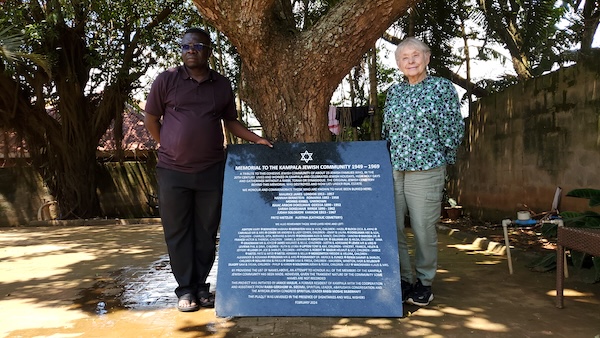
I experienced all sorts of conflicting emotions, as you might imagine. At long last a plaque to commemorate the help that my Uganda Jewish community had given the Abayudaya last century was installed. Nothing had marked the presence of the once-vibrant, secular, 23-family Jewish community, which functioned without a rabbi, a Torah or a synagogue. Who would have guessed that, in 2024, a Conservative and three Orthodox Black Jewish communities would exist, interspersed with Muslim villages?
As for the other plaque I hoped to place, it was for the Jews who were buried more than 60 years ago in the Jewish cemetery just off the Kampala-Jinja Expressway, abutting the Christian cemetery. It is not common knowledge that the Jewish cemetery here had been destroyed and Speke Apartments, built by Dr. Sudhir Ruparelia, lies on top of where it had been. After many months of trying to contact Ruparelia I finally succeeded while in Kampala. In reply to my request to place a plaque somewhere in the vicinity of the apartments, in a discreet corner or on a less important wall, he said “No! None.”
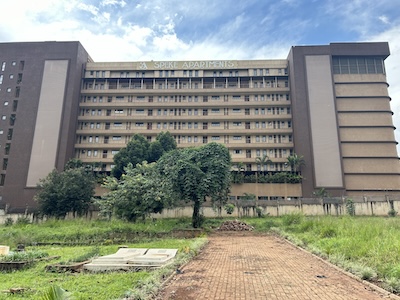
Perhaps I could mount the plaque at the edge of the unkempt Christian cemetery? It requires a Ugandan minister’s permission to approve a location near the 1972 Entebbe Raid plaque at the difficult-to-access old Entebbe Airport. Maybe at the Uganda Museum? The garden of the Chabad compound was also considered. Unfortunately, none of these placements have materialized.
I traveled to Uganda to place two memorial plaques, but my mission was not fully accomplished, and the second plaque lies in storage with Rabbi Sizomu. The Chabad Rabbi in Kampala, Moshe Raskin, said he would try to place it somewhere, perhaps in the future grounds of the new plot of land they will buy for Chabad, because Rabbi Moshe says Chabad is in Kampala to stay.
That I couldn’t find a place to mount the second plaque greatly saddened me. In many parts of the world, history is important and physical spaces or buildings are repurposed and feature plaques to show that a mikvah is buried here or a synagogue was once there. Today, few Ugandans know their local history, including that former governor (1952-1957) Sir Andrew Cohen was a British Jew. He was the first governor not to plunder Uganda’s wealth and he encouraged education and self-rule.
Now it is my task to contact my East African friends and perhaps schools and associations because Albert Kasozi, executive director of Buganda Heritage and Tourism – to whom Prince Joseph introduced me while we drank African tea at my hotel – would like as much 19th-century Bugandan history collected as possible for a new museum that has just been built in Kampala and will be formally opened soon. The banner exhibit I created, Shalom Uganda, will find a home in this new museum and I am very happy about the prospect. And the Kampala memorial plaque? To be determined….
Janice Masur is a Vancouver author and speaker. Her book, Shalom Uganda: A Jewish Community on the Equator, tells her story of growing up in the bygone Ashkenazi Jewish community of Kampala from 1949 to 1961.
Enjoy weekend in Montreal
A bike tour with Fitz Montreal. (photo © Fitz and Follwell Co)
There’s nothing like a weekend in Montreal, whether you’re in the mood for a classic bagel, a mouthwatering babka dripping with chocolate, or a heaping smoked meat sandwich from Schwartz’s Deli. Now that Porter Airlines has launched direct daily flights between Vancouver and Montreal, it’s a great time to explore this fabulous city, which oozes with personality, culture, history and great food.
We joined a fast-paced bike tour to see the city’s highlights, pedaling 15 kilometres through green alleyways, busy boulevards and along the Lachine Canal to get a broad overview of Montreal’s history. We rode through the Old Quarter, with its ancient stone buildings, following the canal past factories and warehouses reincarnated into swanky apartments. We puffed up the hill to the base of Mount Royal and zipped back down past the austere buildings of McGill University.
At Place d’Armes, we stopped to gaze at a pair of statues called “The Two Snobs.” On one side, a Francophone woman holds her poodle, looking with contempt at the head office of the Bank of Montreal, a symbol of English power. On the other, an Anglophone holds his pug, looking with similar disdain at the Notre-Dame Basilica, a symbol of the Catholic Church in Quebec. The statues hint loudly at the enduring, simmering tensions between English and French in Montreal.
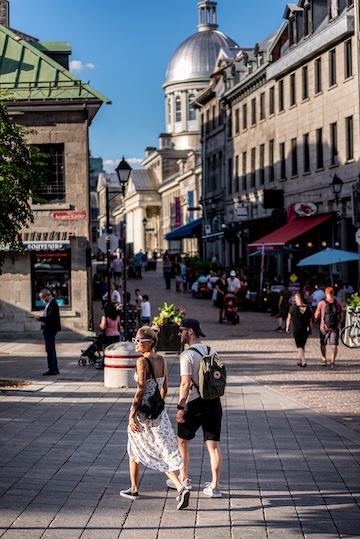
We escaped the tourist crowds in the Old Quarter by heading to Mile End to join a food and history tour offered by the Museum of Jewish Montreal. Our guide, Avery Monette, a 23-year-old master’s student at Concordia, led us on a gastronomic feast as she described the city’s Jewish origins in 1760. That’s when Jews first arrived in Montreal to work as fur trade merchants. The community stayed small until the 1880s, when pogroms drove Eastern European Jews to the safety of Montreal’s Mile End. Over the next 90 years, it would become the largest Jewish community in Canada.
We bit into a sweet, rich cheese crown from Boulangerie Cheskie, a small kosher bakery in the neighbourhood, and then braved the cold wind to line up outside St-Viateur Bagel, one of Montreal’s two most famous bagel shops. Established in 1957 by Hyman Zeligman and Myer Lewkowicz, the store never closes. Ever. “In April 2023, there was an ice and snowstorm that knocked out all the electricity in the area,” Monette recalled. “Even then, this place was open!”
We strolled along rue Jeanne-Mance in Mile End, where frum families pushed strollers alongside us and a man wearing a shtreimel strode by, headed for the synagogue with his tallit tucked under his arm. The Jewish influence was easily spotted, with most houses having mezuzot on their doors and many with the skeleton of a sukkah in their front yard.
By the 1950s, Jews in Montreal had migrated to the middle class, and many left Mile End for larger homes in Côte Saint-Luc, Hampstead and Côte-des-Neiges. We passed the College Français, once the home of the B’nai Jacob Synagogue, which was known as the Carnegie Hall of cantorial singing in its heyday.
Our Vancouver jackets were feeling pretty inadequate in Montreal weather by the time we arrived at Fairmount Bagel, where the line out the door was even longer than at St-Viateur. Once inside, we were surrounded by garlic, pumpernickel, cranberry and muesli bagels, as well as matzah with sesame, onion and poppy seeds. While none of it is kosher, the store is still owned by the same Shlafman family that first opened it in 1949.
A few doors away is Wilensky’s, a small restaurant with origins in 1932 and family members still at the helm. With its Formica counters, bar stools and what could easily be the world’s tiniest washroom, the store feels like a 1930s time capsule. Monette orders the Wilensky Special, an original family recipe featuring beef salami, beef bologna and mustard on a grilled roll. No special requests or modifications are allowed, not for us or for Anthony Bourdain and Mordecai Richler, both of whom were customers.
On Boulevard Saint-Laurent, new stories mingle with the old. We picked up a babka at Hof Kelsten, where Jeffrey Finkelstein is turning heads with his challah, rugelach and rye. We passed Leonard Cohen’s grey-stoned triplex, a house he lived in from 1968 and that’s still owned by his family. “He was well known for padding around the streets in the slippers he bought right here,” Monette says, gesturing at J. Schreter, a shoe shop on the corner.
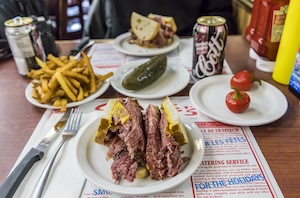
Between the bagels, the babkas and the Wilensky Special, it’s hard to make room for more food, but the length of the line outside Schwartz’s Deli tells us this one is not skippable, so on we go. Famous for its smoked meat sandwiches since its inception in 1928, the deli is now owned by Celine Dion and her partners, who have kept things much the same, adding a smoked meat poutine to the menu. Take a bite of one of Schwartz’s sandwiches, which literally bulge with hefty portions of meat, and you understand precisely why the little deli is such a cultural icon in the city. Quite simply, it’s unforgettable. It’s a fitting symbol for the city of Montreal, which is bursting with flavour.
Whether you come for the food, the history, the arts scene or the culture, Montreal is charmingly seductive, and so vastly different from Vancouver that it feels like an entirely different country. Now just four-and-a-half hours away, it’s an easy decision to put this sophisticated French city on the itinerary.
If you go …
• In April, Porter Airlines launched its daily round trip service between Vancouver and Montreal (flyporter.com)
• A bike tour with Fitz Montreal is a great way to explore Montreal’s highlights, with many sights packed into an exhilarating, fast-paced ride (fitzmontreal.com)
• Museum of Jewish Montreal offers regular Beyond the Bagel Tours in the spring, summer and fall. The three-hour tours include food and range from $79-$95 per person (museemontrealjuif.ca/beyond-the-bagel)
• Humaniti Hotel offers sophisticated accommodation in the heart of the city, steps from Old Montreal, the Palais des congrès and the Quartier des Spectacles (humanitihotel.com)
Lauren Kramer, an award-winning writer and editor, lives in Richmond.
Past echoes in present
Child survivor Lillian Boraks-Nemetz speaks at the community’s Yom Hashoah Commemoration May 5. (Rhonda Dent Photography)
The pogrom of Oct. 7 and the hurricane of antisemitism that has swirled since then added resonance to commemorations of Yom Hashoah this week.
Around the world, Jewish communities united in different ways to mark the annual Holocaust remembrance day. Sunday night, May 5, the local commemoration at the Jewish Community Centre of Greater Vancouver featured child survivor Lillian Boraks-Nemetz, who reflected on the unmistakable parallels across time, of “Broken families, broken bodies and minds and the poor frightened children and much more.”
Recently, said Boraks-Nemetz, she heard the words of Israel’s ambassador to the United Nations, Gilan Erdan, who reflected on how a sunny Shabbat morning in Israel turned, in a matter of seconds, into hell.
“On just such a sunny morning, in Warsaw, I lost my childhood,” said Boraks-Nemetz, who was introduced Sunday night in a touching tribute by her son, Stephen. “The day Nazis invaded Poland, I remember German bombers flying low over my head against an innocent blue sky and as World War Two began on Sept. 1, 1939, I had to become an adult at the age of 6.”
In the war that began that day, she said, 1.5 million Jewish children were murdered. She suffers guilt and questions around her survival when so many, including her little sister, did not live.
“Some of us were younger than others. Some older,” she said. “Nevertheless, we were all traumatized – as our brothers and sisters are today, in Israel, and in a world that won’t learn history and its lessons. We don’t feel safe anymore around our world. Thousands protest against us as they have always done, just looking for a reason to express their hate for Jews.”
Boraks-Nemetz shared parts of her Holocaust history, from the earliest time, when her mother took her to a favourite café only to find a sign declaring Jews were forbidden from entering – signs that then proliferated in parks, recreation areas, theatres, streetcars and elsewhere.
“We were beginning to lose our humanity,” she recalled. “Thousands protested against us with words such as ‘Death to Jews,’ ‘Final Solution’ and more.”
Today, she said, similar words are directed at Jews.
“This is being allowed to flourish unpunished, using our freedom of speech for their purposes,” she said. “But surely there are red lines where free speech ends and hate speech begins that must be punishable by law.”
She recalled seeing the wall around the Warsaw Ghetto being constructed, higher and higher, as she watched.
“I asked my father what this wall means,” said Boraks-Nemetz. “I asked many questions. I was almost 7 years old. This wall, he replied, will eventually enclose a part of Warsaw where we will be forced to live.”
That day came when, through a window, she saw a long car with officers and a bullhorn ordering Jews to enter the ghetto or suffer severe consequences.
“From the day I and my family entered our one room within these close, shabby quarters, I felt as if I had stepped out of sunlight into darkness,” she said. “I felt as if I was being stifled and the feeling of being stifled stayed with me as a memory and a trigger all of my life. The wall meant confinement, exclusion, isolation, fear, hunger and quarantine of a disease called typhus.”
Boraks-Nemetz shared the story of how she was to be smuggled out of the ghetto by her father, who had bribed a non-Jew but, when the day came, she was ill and instead her sister was sent out, never to be seen again.
“The streets were treacherous, with children dying of hunger and disease, poor and starved people peddling what little they had for a few potatoes and stealing what they couldn’t buy,” she said.
While smuggling a child out of the ghetto was a life-threatening act for all involved, so was remaining in the ghetto, she said. Eventually, thanks to an enormous bribe, young Lillian was passed through the gate of the ghetto, where she survived on the outside in the care of her grandmother, who had secured a false identity.
“That day, I felt as if I had lost my family, my home and any degree of safety I had felt,” she recounted. “I became numb and frozen. As a child, I didn’t understand why was I being sent away, alone, into a hostile world. I felt I wasn’t wanted by family or society. That day, I lost my identity as a Jew and a human being, a daughter.”
A forged piece of paper gave her a new, false name, false parents, a false age.
With a small blue suitcase in hand, she walked the short distance from her father, past the bribed guards, who looked the other way, into the care of a waiting stranger who would whisk her to a new, still very hazardous, life outside the ghetto.
“Although it was a very short distance, today I think of it as the longest walk, from impending death to the possibility of life,” she said.
Eventually, she started a new life in Canada, married at 19 and took on the role of a typical Canadian housewife, she said. At 40, she had a crisis, during which she was forced to confront the realities of what she had experienced, a struggle she has addressed ever since, through poetry, sharing her story with students and other means. For her, and for so many others, she said, Oct. 7 brought back from the mists of time the collective consciousness and memory of the past.
“We are still persecuted, blamed, hated,” she said.
Rabbi Carey Brown, associate rabbi at Temple Sholom, spoke earlier in the evening, expressing the need to be careful in drawing parallels between historical events, but acknowledging that the traumas of the past inform reactions to the present.
“It is difficult to distinguish between remembering the past and living in the present,” she said. “It feels inseparable.”
The current generation, said Brown, owes it to the memory of those who perished in the Shoah, as well as to the generations yet to come, “to take seriously and be steadfast in our commitment to ‘Never again.’”
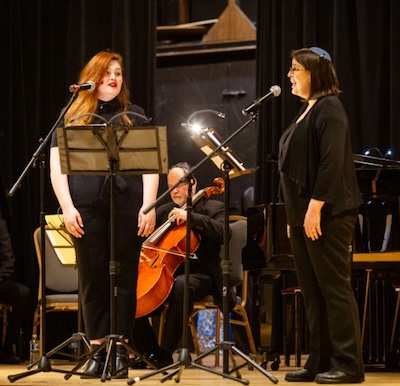
The solemn ceremony began with Holocaust survivors in a procession escorted by King David High School students who are descendants of survivors.
Shoshana Krell-Lewis, a member of the board of directors of the Vancouver Holocaust Education Centre and a daughter of the centre’s founding president, Dr. Robert Krell, welcomed the audience and acknowledged elected officials and survivors. In recognition of survivors from the former Soviet Union, Irena Gurevich translated into Russian.
Sarah Kirby-Yung, deputy mayor of Vancouver, represented the city.
Cantor Yaacov Orzech recited El Moleh Rachamim.
A moving musical program by artistic producer Wendy Bross Stuart featured Eric Wilson on cello and singers Erin Aberle-Palm, Cantor Shani Cohen, Lisa Osipov Milton, Matthew Mintsis, Kat Palmer and Lorenzo Tesler-Mabe.
The program was presented by the Vancouver Holocaust Education Centre, funded through the Jewish Federation annual campaign and by the Province of British Columbia, and supported by the Gail Feldman-Heller & Sarah Rozenberg-Warm Memorial Endowment Fund, Temple Sholom Synagogue and the Jewish Community Centre of Greater Vancouver.
BI celebrates building’s 10th
At the 2012 groundbreaking, left to right: Catherine Epstein, Rabbi Jonathan Infeld, Stuart Gales, Sylvia Cristall, Michelle Gerber, Gary Averbach, Sam Hanson, Shannon Etkin and Alfonso Ergas. Obscured from view is Elliot Glassman. (Robert Albanese Photography)
On June 9, Congregation Beth Israel will celebrate the 10th anniversary of its new building at the sold-out Gerry and Ruby Gales Be the Light Gala. The event will honour the synagogue’s visionary leaders – the Lutsky, Gales, Averbach, Cristall, Glassman and Porte families – and the capital campaign’s co-chairs, Gary Averbach, the late Lorne Cristall and the late Hershey Porte, as well as building chair Alfonso Ergas, Burn-the-Mortgage chair Lee Simpson and former BI executive director Shannon Etkin.
“This new building will be built as a place for our synagogue community to grow and thrive,” Lorne Cristall told the Independent in a 2010 interview, as the capital campaign was starting up.
The new building, designed by Acton Ostry Architects Inc., would give the synagogue an east-facing sanctuary (towards Jerusalem), where it used to face north, and allow the congregation to host High Holiday services under one roof. The plan was to raise enough money that there would be little or no mortgage.
“The campaign began for $10 to $12 million plus about $2 to $3 million for an available piece of land on the southeast corner of the property that Shaughnessy Hospital had expressed a strong interest in purchasing,” Gary Averbach told the Independent in an interview earlier this week. “Even then, while running the numbers, it became quite difficult to see how … we could reach the $10 million mark, let alone the $12 million one.”
That became even more concerning, he said, once the designs were costed out, and the final tally was going to be closer to $18 million.
But the visionary donors being honoured, and many others, gave “unexpectedly generous gifts,” said Averbach, thanking Simpson and Bette-Jane Israels for their help raising the funds, and to Etkin, “who took over after we got the initial pledge.”
Averbach said, “Although we had been incredibly successful in our fundraising, having reached close to $20 million on the day we opened, the final price tag looked to be just over $25 million, and the lot had still not been sold.”
Etkin had found a potential buyer, but, when that deal looked as if it would collapse, Averbach called Gordon Diamond, who had earlier expressed interest in buying the land for possible Vancouver Talmud Torah expansion. It was a long process, said Averbach, “but, finally, thanks to Gordon and Leslie Diamond’s insisting that they find a way, the deal was done.
“There was a final Burn the Mortgage campaign with Lee, Bette-Jane and me. And, under Shannon’s leadership, we were able to pay off all but a little over a million dollars of the final cost of just over $25 million. I believe all that debt has been paid off now.
“An important note is that, of the almost $22 million raised, only two donations, totaling $118,000, came from non-members – and both those had a family history at the BI,” added Averbach.
“I suppose I could talk about all the important roles the Beth Israel synagogue, our shul, my shul, plays in our community, in our personal lives and in our spiritual lives,” Gerry Gales told the Independent about why he and his wife Ruby stepped up. “The answer is not complicated. There was a need. I was asked. I said yes. There was never a second thought in my mind. I do believe we are all here to help one another, to do what we can with what we have.”
He said, “Ruby and I find great comfort in being in our house of worship, our shul…. We know that we are a part of a great tradition, with roots that were planted thousands of years ago. It’s a tradition that will continue long after we are gone. When I think of all the people who have gathered together under this roof, I feel that I am but a small part of something so much larger than me and I feel that I am never alone.
“Then there is the practical role the shul plays in the unfolding of our lives,” he added. “The shul is a place where we come for prayers and to pray, the shul is the place where we can send our children to learn all our traditions and to be educated, the shul is a place where we come to celebrate, where we come to mourn, where we launch our children into adulthood.”
Simpson agrees. “I believe all synagogues play an important part in our Jewish lives. They are a place to gather, pray, gain spiritual renewal, comfort and peace. All so important to our mental and, therefore, physical being – even more important in our world today,” she said. “Plus, they give a sense of community. Seeing familiar faces, sharing a lunch or meal after services, all so important. They are also a place of learning and expanding our knowledge, answer our questions, gain wisdom from others.”
She said it was an honour for her and her husband Bernie to support Beth Israel.
“Beth Israel has been our synagogue for all of our married life – we were married there by Rabbi [Wilfred] Solomon,” she said. “Our children were named there, bat and bar mitzvahs were there and our grandchildren were also named and our grandson’s bar mitzvah has been there, and more to come. I was twice chair of the board of directors and involved in the building campaign.”
As for her involvement in the campaign, Simpson said, “For me, the final straw was at my son’s aufruf [being called to the Torah the Shabbat prior to the wedding]. The auditorium filled with family and friends was also filled with buckets to catch the rain coming in from the roof and windows. We needed more than Band-Aids.”
At the new building’s groundbreaking in 2012, Etkin cited a report from 1988 about a renovation being one of the shul’s “very important priorities.” He spoke about several efforts to move redevelopment forward, with the one that resulted in the new building starting eight years before construction was completed in 2014.
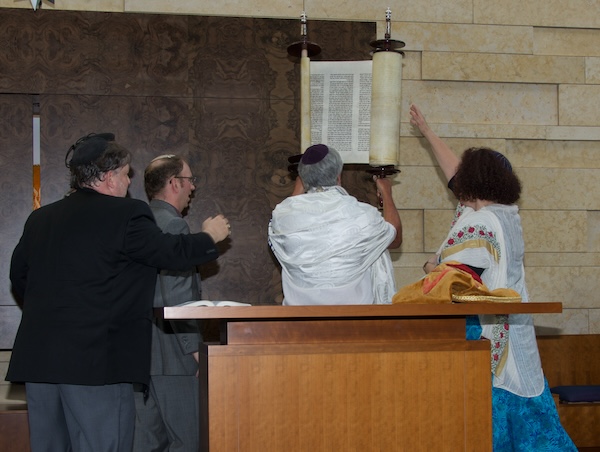
Acknowledging that he stood on the shoulders of Cristall and Porte, who “had been involved as co-chairs in various incarnations of the rebuilding of the Beth Israel Synagogue since at least the early 1990s,” Averbach said, “I had always taken an interest in the project, but it wasn’t until I joined the board around 2008 that I started to take an active interest. My interest was based on the fact that the existing building, besides being arguably halachically incorrect, was also in very sad disrepair.”
Cristall and Porte took Averbach out to lunch and asked him to deal with donors under the age of 55.
“After a few days, I agreed, and a couple of weeks later, Hershey passed away, and the ‘triumvirate,’ with me as junior partner became Lorne and me as co-chairs,” said Averbach. “Given Lorne’s serious illness, I knew my job had expanded many times.”
With the help and work of many people, and with the commitment of the congregation, the redevelopment finally happened.
“Since we opened our doors to our new and very beautiful building 10 years ago, we have seen significant increases in every aspect of synagogue life. Our membership is growing, and our program participant numbers have increased,” BI Senior Rabbi Jonathan Infeld, told the Independent. The clergy now includes Assistant Rabbi Adam Stein, Ba’alat Tefillah Debby Fenson and youth director Rabbi David Bluman.
“Since our new building project was completed, it has literally opened many doors for our congregation,” said Infeld. “We have had the blessing of hosting many large community events including this year’s Yom Ha’atzmaut celebration. We have had the flexibility to do many great programs that utilize all our spaces and meet the needs of many different age groups. The High Holidays are a perfect example of when we use almost every inch of the building. We have nearly 2,000 people come to our various High Holiday services each year and the space is a true blessing for all of us.” It also allows for more varied services and programs on Shabbat, said the rabbi.
“We are really looking forward to our sold-out gala this year, which will celebrate a decade of success because of the hard work and dedication of the people who helped make the dream of a new building possible,” he said. “I am so happy that there will be so many people present to say thank you to our visionaries and builders. Jacci Sandler and the gala committee have done a fabulous job already.”
The gala committee is Jennifer Apple, Kerry Benson, Samara Bordan, Chana Charach, Shannon Ezekiel, Shannon Gorski, Carol Konkin, Samantha Levin, Juliette Sandler, Paige Swartz and Leatt Vinegar. Sandler, head of development at Beth Israel and the creator of the Be the Light Gala, spoke with the Independent about this year’s event, which will feature, among others things, a concert by American-Israeli rapper/singer Nissim Black and a menu created by Israeli Chef Yaniv Cohen, owner of restaurant Jaffa Miami, and the Perfect Bite. Howard Blank will be the auctioneer and Sandler’s husband, Brett, will be master of ceremonies – he has a long history of fundraising in the community and chaired the JCC Sports Dinner twice.
For the main act, Jacci Sandler wanted an internationally known Israeli artist. Black fit the bill, and more.
“Not only are Nissim’s songs all about Judaism but they are filled with messages of spirituality, about hope, victory, friendship, belief, admiration, being lifted and much more,” said Sandler. “At the time we are in now, the Jewish community wants to be lifted and, at the Be the Light Gala, Nissim, with his beautiful words, will do just that. I received approval of this concept by my outstanding gala committee and executive director Esther Moses.
“With the occurrences in Israel this year, we wanted to celebrate the 10th year with an Israeli meal,” Sandler continued. “But we wanted a concept out of the box from the traditional options in Vancouver. Ricci Smith teamed up with Yaniv Cohen to do a Miami-style version of our Israeli meal… Our meal will be incorporating seven Israeli spices that represent kindness, strength, beauty, perseverance, splendour, foundation and royalty.”
Shannon Chung, with whom Sandler has worked before, will perform at the donor reception, which will be hosted at the house of Mark James.
“Beth Israel Synagogue is an essential part of who we are,” said Gerry Gales. “It serves the spiritual and human needs of us, the congregants. It is a focus for our Jewish community that allows us to come together and share our lives, for better or for worse, with each other. And our synagogue plays a role in making us a visible part of our larger community, the Vancouver community.
“In these stressful times, with war in our homeland and revival of old evils and antisemitism around us, we need a place where we can come together, where we can stand together. This is that place. The synagogue needs funding to be what we need it to be, and it needs our participation. If we do not fund it, if we do not make it work, who will?”
Averbach had a message for BI’s future generations.
“Just as I and many others worked long and hard at the renovation of the JCC between 1988 and 1995 and, just over 20 years later, we need to rebuild, so it will be with the BI,” he said. “Maybe it’ll be 30 years, but just remember – never underestimate the generosity of Greater Vancouver’s Jewish community!”

